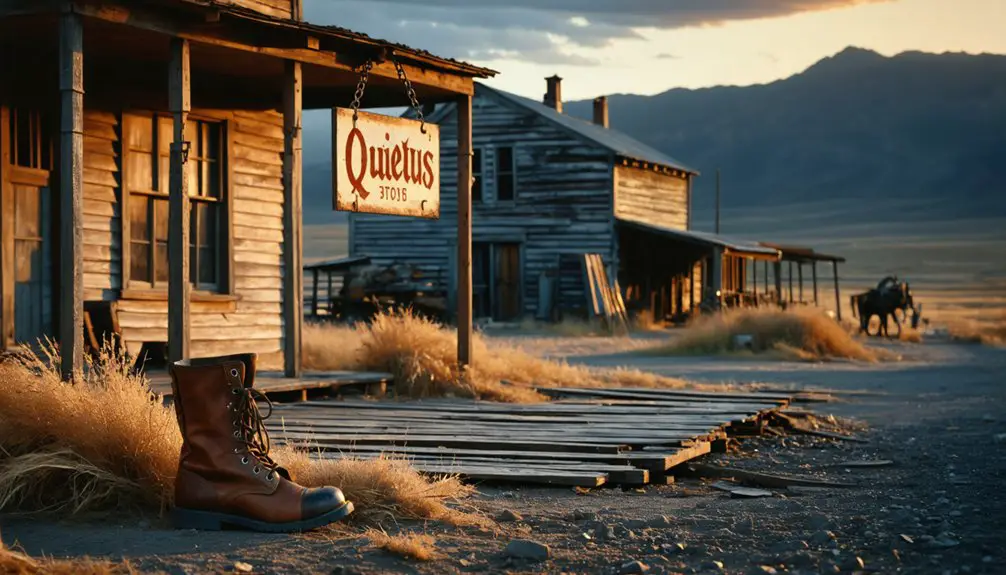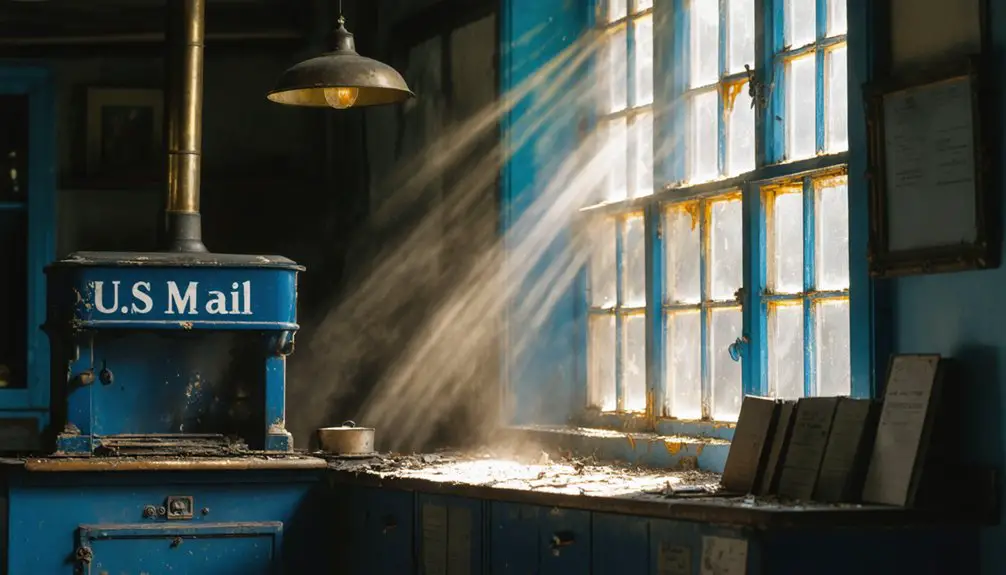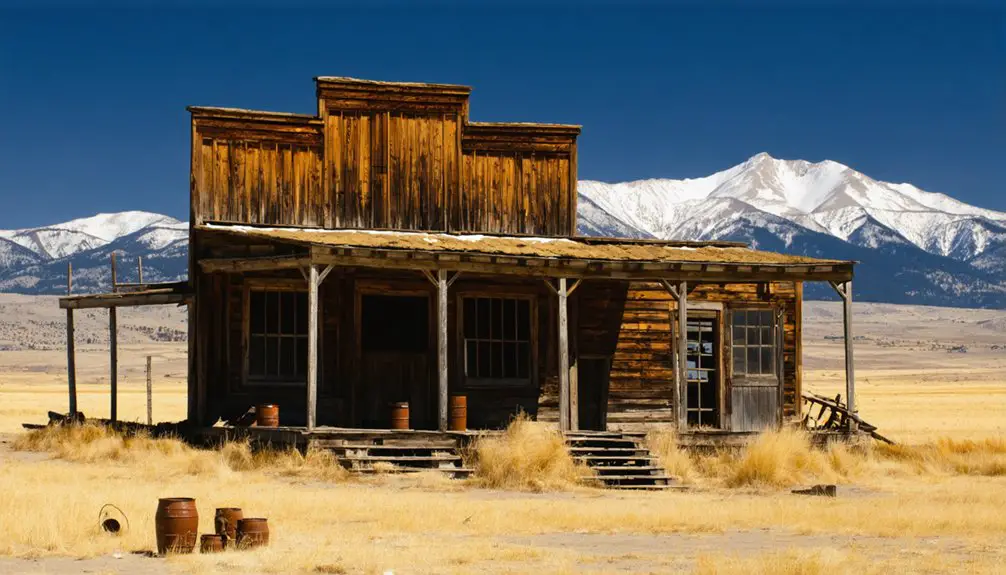You’ll find Quietus, Montana tucked away as a ghost town memorial to early 20th-century homesteading life. Founded in 1907 by Frank Brittain after fifteen rejected post office names, this small settlement served ranchers along Otter and Quietus Creeks. While never growing beyond a dozen residents, it maintained postal services until 1960. Today, you can still spot Milton Phillips’s historic log post office at the intersection of Quietus Road and Decker Road – a window into Montana’s pioneering past.
Key Takeaways
- Quietus was founded in 1907 by Frank Brittain and established its post office after 15 rejected names from postal authorities.
- The ghost town’s original post office building, housed in Milton Phillips’s log house, still stands at Quietus Road and Decker Road.
- Quietus primarily served ranchers and homesteaders along Otter and Quietus Creeks before declining due to rural depopulation.
- The post office ceased operations in 1960, marking the town’s transformation into a ghost town with few remaining structures.
- Visitors can explore the ghost town via a loop road, though the site remains unmanaged with no formal tourism infrastructure.
The Birth of an Oddly Named Settlement

The founding of Quietus, Montana presents a rare case where bureaucratic frustration birthed a town’s name. In 1907, Frank Brittain’s attempt to establish a post office for local homesteaders led to a quirky origin story you won’t find elsewhere in the American West.
After submitting 15 different names – all rejected by postal authorities – Brittain remarked they’d “put a quietus” on his efforts. His wife seized on this humorous anecdote, suggesting they submit “Quietus” itself as the town name. The strategy worked, and in 1917, Brittain’s daughter Ada Rigby became the first postmaster.
You’ll find this settlement’s emergence typical of early 1900s Montana homesteading communities, but its naming stands uniquely as a reflection of frontier wit overcoming government red tape. Like many Montana towns of that era, including Elkhorn which saw its population reach 2,500 during the mining boom, these settlements grew rapidly as economic opportunities emerged.
Life in Early 20th Century Quietus
Beyond its unusual naming story, life in early 20th century Quietus exemplified Montana’s stark homesteading realities.
You’d find a small, tight-knit population of determined ranchers and homesteaders carving out their existence along Otter and Quietus Creeks. Ranching life dominated their days, with families raising livestock and maintaining self-sufficient farms in the challenging valley environment.
Hardworking homesteaders carved out lives along Montana’s creeks, raising livestock and maintaining farms in the unforgiving valley.
The post office served as their lifeline to the outside world, though infrastructure remained minimal. You’d see log houses dotting the landscape, connected by simple dirt tracks.
Despite isolation and frequent hardships, including food shortages, strong community bonds prevailed. Neighbors supported each other through harsh winters and crop failures.
The settlement’s population never grew large, and by mid-century, fewer than a dozen residents remained.
The Post Office Saga

You’ll find the origins of Quietus’s postal service stretch back to 1907, when local homesteaders first received mail routed through Wyoming before establishing their own post office.
The log house that served as the post office from 1924 still stands at the intersection of Quietus Road and Decker Road, offering a tangible connection to the town’s past.
Milton Phillips, who served as the final postmaster at this location until 1950, witnessed the gradual decline of both the postal service and the town’s population before operations ceased entirely in 1960.
Mail Service Origins 1907
When Quietus secured its post office in 1907, this significant development marked the beginning of organized mail service for homesteaders and ranchers scattered throughout Montana’s Otter and Quietus Creek valleys.
You’ll find that this establishment proved indispensable for the community’s survival, as the post office connected isolated settlers to essential mail routes and supply networks across Big Horn County.
The post office’s community significance extended beyond basic mail delivery:
- Served as a central hub for dispersed valley homesteads
- Connected local settlers to broader Montana postal networks
- Facilitated crucial commerce and communication
- Provided a foundation for community identity and growth
Though the immediate area never exceeded a dozen residents, the post office’s presence guaranteed settlers maintained important links to the outside world, fostering independence in this remote Montana territory.
Postal Building Still Stands
The physical legacy of Quietus’s postal history endures through Milton Phillips’s log house, which served as the town’s post office from 1924 to 1950.
You’ll find this historical structure at the intersection of Quietus Road and Decker Road, perched on a hillside as a symbol to the area’s rich log house history.
While some sources claim the building has collapsed, others confirm it’s still standing as a rare surviving relic of Montana’s rural postal service significance.
The building’s presence, whether in ruins or intact, marks the physical footprint of this former frontier community.
Though Quietus has transformed into a ghost town, nearby ranching families maintain their connection to this historic postal site, preserving its role in the region’s cultural memory.
Last Postmaster’s Final Days
After serving as Quietus’s first postmaster since 1917, Ada Rigby handed over her duties to Milton Phillips in 1924, ushering in the post office’s final chapter.
You’ll find that Phillips faced significant postmaster challenges as he operated from his log house during a time of declining population. Despite dwindling numbers, he maintained crucial community connections through his dedicated service until at least 1950.
- Phillips’ log house served as the post office hub for 26+ years
- The post office relocated twice more before closing in 1960
- Rural families relied on the office for both mail and social interaction
- Community bonds persisted even as services diminished
Through Phillips’ tenure, the post office remained more than just a mail center – it was the heart of Quietus until its final days, marking the end of an era.
From Bustling Homestead to Abandonment

Despite its humble beginnings as a post office settlement in 1907, Quietus never achieved the bustling status of Montana’s mining boomtowns. Instead, it maintained a modest existence as an agricultural community along Otter and Quietus Creeks.
Unlike some towns that featured thirteen saloons during their heyday, Quietus’s trajectory was defined by homesteading challenges from the start. Some mining settlements like Comet City paid workers 3 dollars per day, showing the economic disparity between agricultural and mining communities. Unlike mineral-rich towns that experienced dramatic boom-bust cycles, this settlement’s fate was tied to the harsh realities of subsistence farming and ranching.
Rural depopulation took its toll by mid-century, as residents sought opportunities in more accessible locations. The community’s isolation and lack of transportation infrastructure sealed its destiny, with the population dwindling to fewer than a dozen people before the post office’s closure in 1957.
Without essential services, the remaining homesteaders departed, leaving Quietus to fade into Montana’s landscape.
What Remains Today
Remnants of Quietus’s former existence are sparse, with only a deteriorating post office building and a visible loop road marking where this Montana settlement once stood.
Like many abandoned mining settlements across Montana, when you visit today, you’ll find the site has largely returned to its natural state, with most structures having disappeared into the southeastern Montana landscape. Current conditions reflect complete abandonment, though the area’s scenic location near Otter and Quietus Creeks still draws occasional history enthusiasts. Much like Nevada City’s panning techniques, early prospectors here searched the creek beds for valuable gold deposits.
- No active preservation efforts maintain the remaining structures
- Loop road provides primary access for ghost town explorers
- Post office ruins serve as the main physical reminder of settlement
- Site exists primarily as an unmanaged historical location
The visitor experience is self-guided, with no formal infrastructure or interpretive features to assist in understanding Quietus’s past.
The Legacy of Frank Brittain

While modern-day Quietus stands nearly empty, its historical significance centers on Frank Brittain, the pioneer who shaped both the town’s identity and development.
As a community leader, Brittain’s impact endures through the town’s distinctive name, which he cleverly proposed after the Post Office rejected his initial fifteen suggestions.
You’ll find his influence embedded in the region’s early infrastructure, particularly through his establishment of postal services that transformed the area into a crucial communication hub.
His daughter Ada Rigby’s role as the first postmaster further cemented the Brittain family’s leadership within the community.
Ada Rigby broke ground as Quietus’s first postmaster, strengthening her family’s enduring influence in the frontier town’s development.
Through his homesteading efforts and push for postal services, Brittain’s legacy lives on in the settlement patterns he helped establish and the historical narratives that continue to define Quietus’s frontier spirit.
Preserving Montana’s Rural Heritage
As Montana confronts mounting heritage preservation challenges, state agencies and organizations have implemented strategic programs to safeguard rural historical sites like Quietus. The state’s heritage conservation efforts face a significant funding gap of $12.4 million, yet innovative solutions are emerging through public-private partnerships and grant programs.
Key rural preservation initiatives include:
- The Montana Historical Society’s RMRH grant program offering up to $100,000 for historic property rehabilitation
- A thorough Cultural Records Database containing over 100,000 documented heritage sites
- Private landowner conservation easements protecting 2.5 million acres
- State management of 366 heritage properties with over 1,000 individual components
You’ll find these programs particularly essential as they help protect Montana’s ghost towns and rural landmarks while balancing public access with preservation needs.
The state’s matching funds maximize limited federal resources, ensuring continued protection of these irreplaceable historical assets.
Frequently Asked Questions
Are There Any Documented Paranormal Activities or Ghost Stories From Quietus?
You’ll find ghost sightings at Kelley’s Saloon where piano music plays at night, and haunted locations include cabins where stoves open mysteriously. Shadowy figures appear in windows, while visitors report being followed.
What Was the Peak Population of Quietus During Its Most Active Period?
You’ll find the peak population never exceeded a few dozen residents during Quietus’s most active period in the early 1900s, as town demographics show minimal growth without mining history driving expansion.
Did Any Notable Crimes or Dramatic Events Occur in Quietus?
You won’t find any murder mysteries or historic heists here – historical records show no documented crimes or dramatic events during Quietus’s existence. It remained remarkably peaceful throughout its short-lived settlement period.
Can Visitors Legally Explore the Remaining Structures at the Quietus Site?
You can’t legally explore Quietus structures without landowner permission, as they’re on private property. Given exploration regulations and visitor safety concerns, you’ll need explicit consent to avoid trespassing charges.
Were There Any Schools or Churches Established in Quietus?
You won’t find any church significance or school history in Quietus – historical records show no formal schools or churches were ever established there. The community relied solely on its post office.
References
- https://en.wikipedia.org/wiki/Quietus
- https://kids.kiddle.co/Quietus
- https://www.youtube.com/watch?v=8DRaKMLZvcs
- http://www.lostandfoundmontana.com/towns/quietus.html
- https://www.mountain-home.com/blog/vacation-planning/guide-montana’s-ghost-towns
- https://www.youtube.com/watch?v=J38tAc_Z5rw
- https://www.legendsofamerica.com/gt-hiddentales/
- https://www.youtube.com/watch?v=iPksI1nuqm4
- https://mhs.mt.gov/education/Elementary/20thCentury.pdf
- https://www.onlyinyourstate.com/state-pride/montana/historic-photos-early-1900s-mt



